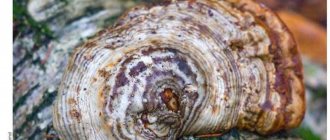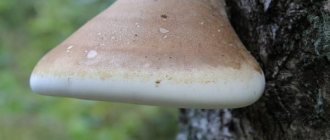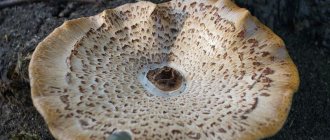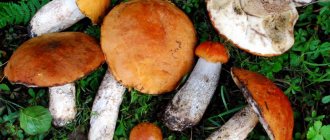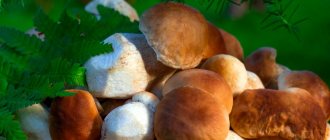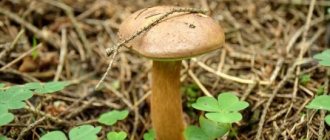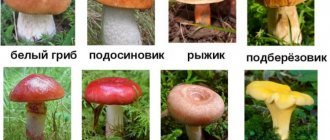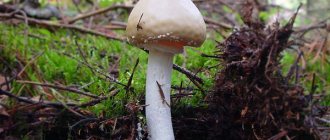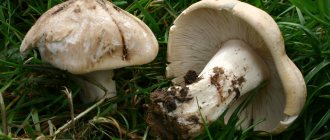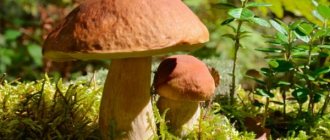Reasons for the growth of mushrooms on tree stumps
Individuals settling in this way are classified as saprophytic fungi that feed on the remains of various microorganisms. They parasitize on the body of a stump or living tree, destroying the wood. Fungal spores spread in areas of damage, forming mycelium, which allows the fungi to go deeper into the wood, affecting it.
Causes of mushrooms on stumps:
- Mechanical damage (cutting, breaking).
- Irregular garden care.
- Pest damage to trees.
- Special colonization of fungal spores on stumps or trees for the purpose of growing edible species.
Description of white rows and what these mushrooms look like (18 photos)? Rowers or Tricholoma are mushrooms common in the forests of Russia and other countries of the Northern Hemisphere. Their name is...Read more...
Wood-destroying edible mushrooms grown in households or on large farms (honey mushrooms, oyster mushrooms, shiitake mushrooms) have become a source of good profit in modern business.
Poisonous wood-destroying organisms cause irreparable damage to fruit trees, leading to their death and contamination of the entire garden. Therefore, trees affected by such parasites should be uprooted and destroyed in a timely manner to prevent the spread of fungal spores to other plants.
Features of growing mushrooms on stumps in the country
All types of edible hemp mushrooms can be grown at home. Instead of stumps, you can use cuttings of deciduous trees. But you can plant fruits on fresh stumps left after recently cutting dry trees.
Note!
Growing oyster mushrooms, which love poplar, maple and birch, is very popular. However, it is not recommended to use conifers due to the high content of resins, which can destroy the mycelium.
You may be interested in: How do edible talkers differ from false mushrooms? How many days after rain do mushrooms grow? Bitter mushroom: photo and detailed description
When growing fruiting bodies on dry wood, it must first be prepared. For this purpose, use a container of clean water. After preparation, you can proceed to moving the mycelium of the selected type of mushroom. To do this, indentations are made in the hemp so that their arrangement resembles a chessboard. Maximum depth 6 cm, width 1 cm.
The mycelium is placed in these holes. Subsequently, the cells are closed with moss or tape. All “inhabited” logs must be placed in a cold room - a basement or cellar. The stumps should be folded into a pyramid-like shape and burlap should be placed on top.
Home cultivation of mushrooms is not limited to the use of stumps. After the mycelium germinates, the stumps need to be planted in the ground. In order for the further process to proceed without failures, the improvised soil needs to be watered from time to time. If you do everything correctly, then pretty soon you will be able to harvest your homemade mushrooms.
Edible types of mushrooms growing on stumps
Edible mushrooms are sometimes difficult to recognize, but the special features are clearly visible in the photo, and you just need to remember the name and description of each.
The most popular edible mushrooms, growing on living or rotten wood in nature or grown artificially, are red and yellow honey mushrooms, located in nature in groups on old coniferous stumps (spruce, pine). They find their wide application in cooking. They are pickled, fried, canned, salted, without fear for their health.
Due to the content of a large number of microelements (copper, zinc) involved in the formation of blood cells, eating honey mushrooms has a beneficial effect on the body. However, among honey mushrooms there are their doubles, which are called false and are poisonous. A distinctive feature is the presence of a ring on the stem of edible fruits. There are such varieties of edible mushrooms:
- winter honey fungus (Flammulina velutipes). Often noticeable due to its bright orange color. The cap has a smooth transition from bright to dark shades, condensing towards the center. The leg is covered with small fibers. The pulp is whitish, with a pronounced mushroom aroma. Due to its good resistance to low temperatures, winter honey mushrooms can be found in winter under the snow on damaged wood of deciduous trees (willow, poplar);
- summer honey fungus (Kuehneromyces mutabilis). Spreads on decaying larch trees. A small brown or dark yellow cap up to 6 cm in young fruits of a convex shape, in the oldest ones it evens out over time. The leg grows up to 7 cm long. It has yellow flesh with pleasant aromatic qualities;
- autumn honey fungus (Armillaria mellea). Settles on rotten alder, aspen, and birch stumps. The hat is quite large, up to seventeen centimeters in circumference, greenish or brownish in color. The legs grow up to ten centimeters, externally scaly, light brown. The pulp is dense and fragrant.
Other edible mushrooms:
- oyster mushroom (Pleurotus cornucopiae). The funnel-shaped cap of a light gray color (3-12 cm) gave the oyster mushroom its name. The leg is centrally located, (2-6 cm), covered with small plates. White, somewhat compacted dense pulp with a delicate odor. You can observe the spread of oyster mushrooms on deciduous stumps;
- curly griffola (Grifola frondosa) or ram mushroom. Recognized by its fused solid cap and light short stem. Grifola has dense, tasty, white flesh. Grows on oak or maple stumps, growing up to ten kilograms in weight;
- common liverwort (Fistulina hepatica). It looks like a liver. The cap is semicircular, reddish-brown in color, reaches 30 cm, and has a short stem. Red, dense pulp with an unusual sour taste, smelling of fruit. Loves oaks or chestnut trees, and in rare cases other deciduous plants. Reaches active growth from late summer to October;
- tiger sawfolium (Lentinus tigrinus). It grows in summer and autumn, settling on deciduous trees. The cap is scaly, 4-8 cm in diameter, nut-colored. The scales covering the cap are most often brown. Curved leg 3-8 cm. The fruit body is somewhat harsh, without a particularly pronounced odor. It is a high protein product;
- cellular polyporus (Polyporus alveolaris). These mushrooms grow on deciduous stumps in the spring and summer. A reddish-yellow oval-shaped cap up to eight centimeters in diameter, covered with small scales. The white leg, located on the side, is approximately 10 cm long. The pulp is white, particularly hard and has a delicate odor;
- scaly polypore (Polyporus squamosus). The most popular species, growing on stumps and trees in park and forest areas. Its main difference is a scaly, leathery, yellowish cap measuring up to 30 cm in diameter. The leg is scaly, brown, 10 cm long. The pulp is aromatic, dense and juicy. Young specimens of tinder fungus are most suitable for cooking, since its older representatives are tough;
- sulfur-yellow tinder fungus (Laetiporus sulphureus), chicken fungus. Parasitizes fruit and coniferous trees. A yellowish drop-shaped cap measuring from 10 to 40 cm is located on a barely noticeable yellow stalk, with elastic and juicy pulp.
Although the presented varieties of mushrooms are edible, they require careful heat treatment before cooking.
You may be interested in:
How to recognize a mushroom with a cap and a white stalk: names and types (32 photos) Mushrooms are a wonderful culinary product, successfully used for preparing various dishes. The most…Read more…
What mushrooms and why grow on stumps
A variety of mushrooms grow on stumps and trees - edible, inedible and poisonous. They use wood as nutrient soil for themselves. It doesn’t matter whether the tree is dry, rotten, or in the active growth phase. Different fruits grow on equally different members of the tree family.
Some species perform the function of peculiar orderlies. They grow on stumps and dead wood, “sending” mycelium deep into their thickness and feeding on the remains of wood. Under this influence, its destruction occurs, and the land is freed for new vegetation. This process proceeds very slowly, but steadily.
Nurse mushrooms are edible, but there are very few of them. Often on trees you can find such tasty and healthy fruits as:
- Honey mushrooms. They usually grow on the lower part of trees (which is why they got their name).
- Oyster mushrooms. They prefer tree trunks or stumps.
- Ram mushroom, or curly griffola. It has a characteristic appearance, for which it received its name.
- Liverwort. This plant loves living trees. The mushroom got its name for its external resemblance to animal liver.
- Coral-shaped hedgehog. It’s hard to believe, but this is also a mushroom, and a very tasty one.
- Tiger sawleaf. The mushroom loves deciduous trees. Valued for its high protein content.
- The tinder fungus is cellular. It grows on trees and stumps. It is unpretentious in conditions - it can reproduce in both deciduous and coniferous forests.
But, in addition to useful and edible ones, you can also find dangerous varieties on stumps that are best avoided:
- Ischnoderma resinous. A member of the Fomitopsis family. The mushroom is inedible and hazardous to health.
- Ganoderma oleoresin (resinous). Refers to tinder fungi. It grows everywhere, but is rare in Russia.
- Oligoporus astringentus. This fruit has one interesting feature: it has the ability to secrete drops of liquid. For this reason, he appears to be “crying.”
- Trametes covered. An annual tinder fungus that usually grows in groups. Loves dead wood, dead wood, and stumps.
Poisonous and inedible types of mushrooms
There are much more unedible mushrooms that like to settle on stumps than edible specimens. If they enter the body, they cause irreparable harm. Inedible mushrooms growing on stumps are represented by Ganoderma, Ischnoderma, Postia and others; from the photo and detailed description, one can identify special characteristic features that other species do not have:
- southern ganoderma (Ganoderma australe). This mushroom is distinguished by a compacted, rather large cap 40 x 13 cm, dark brown in color. The leg is not clearly defined. The brown flesh is soft. Favorite places to grow: poplar, oak, linden stumps;
- resinous ichnoderma (Ischnoderma resinosum). The parasite settles on beech, birch, fir, and linden trees, causing putrefactive changes in the wood. It has a bronze-colored cap, reaching 20 cm. During growth, the cap secretes a reddish liquid in the form of drops. The pulp is poisonous, white, and juicy;
- oak piptoporus (Piptoporus quercinus). A fan-shaped fruiting body is 10-15 cm in diameter with a beautiful velvety surface, yellowish-brown in color. Settles mainly on oak trees;
- astringent postia (Postia stiptica). The mushroom is quite recognizable by its whitish bodies, which can take different shapes. Young postia are covered over the entire surface with drops of liquid. The pulp is quite dense, juicy, and bitter. The fungus prefers coniferous crops for settlement;
- fluffy trametes (Trametes pubescens). Favorite place to grow: birch and conifer stumps or dead wood. Settles in groups. The hats are covered with delicate fluff. The color comes in various shades of grey. The pulp is white, dense.
Having a beautiful appearance and aroma, inedible mushrooms attract the eye and are easily confused with edible specimens, so you should pay special attention to their description.
Names of inedible mushrooms
Among all the fruits that grow on stumps, there are also inedible ones. You need to be able to recognize them, if not immediately, then after a thorough examination.
Ischnoderma resinous
The fruit measures about 20 cm, the thickness of the cap is 3-4 cm. The surface is smooth, there are black areas on it. The hymenophore is tubular, creamy in young fruits, darker and brown in mature ones. Grows on dead wood, stumps, and dead wood from early August to late October.
Ganoderma oleoresin
It grows from the bark of a tree, so, in fact, it has no stem. The cap is flat and looks like a comb. With its wide part, the fruit is attached to a tree or to the ground (sometimes it grows on the soil). The flesh is dark in color and soft to the touch.
Oligoporus astringentus
A tinder fungus that grows everywhere. It has a light, often white color. The edges of the caps are most often sharp, less often they are blunt. Can grow singly or in groups.
The pulp is fleshy and juicy. However, its taste is very bitter. The thickness of the cap section varies from 3 to 4 cm. The surface of the fruiting body is bare, but there may be slight pubescence.
The mushroom is unpretentious and can grow in almost any conditions. It has fleshy pulp that has a bitter taste.
Trametes covered
This inedible fruit has a gray surface and leathery flesh. It grows mainly on the wood of pine trees, but it can also be found on birch trees. As a rule, it prefers stumps as nutrient soil. The mushroom has a bitter taste, which is not neutralized during heat treatment.
Mushrooms used in folk medicine
There are varieties of mushrooms of this type that are effectively used in folk medicine to treat various diseases; they are added to medicinal tinctures, decoctions, and added to ointments:
- larch sponge (Fomitopsis officinalis) or agaricus. The mushrooms are white or pale yellow in color, oblong in shape, similar to an animal’s hoof. They can reach 10 kg in weight. They grow on coniferous trees or larch stumps. When used as part of a medicine, it weakens, stops bleeding, calms, and acts as a mild sleeping pill. Used to reduce sweat secretion;
- lacquered tinder fungus (Ganoderma lucidum), or reishi. It is easily seen on the stumps of destroyed deciduous trees. The cap is ovoid or kidney-shaped, red-brown in color, covered with delicate, smooth, shiny skin. The pulp is ocher-colored and tasteless. Medicines made from the varnished tinder fungus have antitumor and immunostimulating effects, improve blood circulation and metabolic processes, and normalize blood pressure.
- tinder fungus (Inonotus obliquus) or chaga, or birch mushroom. It affects alder, birch, maple stumps, as well as trees, growing up to forty centimeters in diameter. The body is black, irregularly shaped in the form of a growth covered with small cracks. As part of the drug, it has antigastritis, antitumor, diuretic, and antispasmodic effects.
white
Suitable Not suitable
Name of the mushroom
Alternative descriptions
• Andrey (pseudonym of Boris Bugaev) (1880-1934) Russian writer, novel “Petersburg”
• city in Russia, Tver region, on the Obsha River
• composer, author of the song “Eaglet”
• coat color of a Persian cat with blue, orange or different colored eyes at the same time
• edible mushroom
• Russian actor who played the role of Spam in the film “Paragraph 78”
• Lyubov Mendeleeva ended her relationship with this poet when he decided to fight with her husband Blok, and then shoot himself
• the name of this city in the Tver region indicates its exemption from some duties
• island in the Kara Sea
• Boris Nikolaevich Bugaev wrote under this pseudonym
• city in the Tver region
• Boris Bugaev
• military journalist, writer, author of the novels “Zero Cycle”, “Silver Pearl” and the story “Inheritance”
• … bear
• the role of E. Leonov in the film “Gentlemen of Fortune”
• basaltic shield volcano, located in Central Kamchatka
• Coat color of a Persian cat with blue, orange or different colored eyes
• Russian writer, one of the leading figures of symbolism, real name Bugaev (1880-1934)
• City in the Tver region
• Andrey (pseudonym of Boris Bugaev) (1880-1934) Russian writer, novel “Petersburg”
• military journalist, writer, author of the novels “Zero Cycle”, “Silver Pearl” and the story “Inheritance”
• composer, author of the song “Eaglet”
• about color, suit, paint: colorless, opposite to black. in a comparative sense, light, pale. White wine, white beer, honey, plums; white face, white bread, so called to distinguish it from red (wine, honey), black (beer, plums, bread), green (bread wine), etc. Clean, unstained, unsullied. White scarf, shirt; white paper, white floor. The shirt is black, but the conscience is white. Go out onto the porch, show your white face. The hand washes the hand, and both live. What does it matter to anyone that my wife is not white, I am not good myself. White hands love other people's works. He speaks white, but acts black. White-handed, clean-spitting, but smart enough (or worn out). He is white-faced and thin as a father. White as a harrier, as white as a cloth (linen, tablecloth, towel), as white as a wall, as white as snow. Whiter than snow. Then it will be a holiday for the orphan when they give him a white shirt. Black vestments will not save, white (variegated) ones will not destroy. White money about a rainy day. The snout (clothing) is black, but the conscience is white. White wedding, black sad. The world is white, but the people are black. The black cow gives white milk. Eats white, drops black? the torch is burning. He who is brave is white. To each his own and unwashed white. You can't make white out of black. My little one has a white face. A son was born, like white cheese. The soap is gray, but the wash is white. The shirt is white, but the soul is black. Black males must be washed white. Young girl, white teeth. Star. white or whitewashed, free from tax; white land, the white place is still called church land; white peasants, free from all taxes and duties, white peasants, white landowners, white-haired (?). There are white peasants in the Olonets province, granted for services to Tsarina Martha Ioannovna; and the Belopashtsy, in Kostroma, are the descendants of Susanin. The people call their faith, the Tsar and the Fatherland white. White Rus' is not without good people. In addition to Great, Lesser and New Rus', the rest, that is, the western part of it is divided into White (Mogilev, Vitebsk, Minsk), Black (Grodno, Kovna) and Chervonnaya (Volyn, Podol). Belotorgovy, old. a redneck selling lord's goods. White light, Belsvet, free light, open world, freedom on all four sides; the whole light, the world, our whole land and all the people. Belsvetny, nabelsvetny, everything that is in the whole or in the white world. Drive away from the world. To live without the truth is to flee from the world. You can't wash a black dog white. Do not bring your mother into this world. There is no friend: not even the world is nice. I’ll go out for a walk and yawn in the white light. Money about a white day, money about a red day, and money about a rainy day. The snow is white, but not tasty; The poppy is black, but the boyars eat it. Black will not stick to white. White clergy, non-monastics, who are called black. White lady, St. Petersburg. friendly address of sellers and peddlers to customers. White day, all day, all day, God's day. White sheet, white paper, blank, unwritten. White forest eagle. Kaluga birch forest, birch forest; but in general; birch, aspen, hornbeam, beech, linden. White beech, white oak, types of these trees. White color, fireweed flower, Leucanthemum vulgare plant. Porcini mushrooms, sometimes called: boletus mushrooms, birch mushrooms and porcini mushrooms themselves, are the best of all our mushrooms, but for the most part they mean only the latter. White cabbage, the hard and clean heads of common cabbage from which the outer leaves that make up the gray cabbage have been removed. White goods, shoe, undyed goods, tanned. White fish or belchug m. kamch. a genus of herring, rune, schooling fish; in general, in some places they call any small, scaly fish this way, distinguishing it from black (large scaly) and red (beluga, sturgeon, thorn, stellate sturgeon, sterlet). White fish, white fish, fish from the genus salmon, Salmo leucichtys. White weapons, cold, melee, sharp, non-fire: saber, bayonet, spear, dagger. White pants (military red), rank of general. White powder, used for arrow caps, and not for charges, mercury fulminate and other compounds. White rund, military detour, to inspect the sentries before sunrise. White stone, a rock consisting primarily of feldspar; in the thieves' trade, arsenic. White stone, white-flammable stone, sometimes with the addition: alatyr, alabyr, magical, mysterious, remembered in songs, fairy tales and conspiracies (electron, amber?). White ore, gold, telous gold; lead, lead carbonate. White gold, pale, by the admixture of silver or by the method of finishing; opposite sex red. White iron, unusually soft, whiter than usual, is found in Spanish gun barrels. White iron or tinplate, sheet iron covered with tin, tinned. White cast iron, ardent, bright, hard and brittle cast iron. White silver, from assayers, is the purest, not containing a noticeable amount of ligature, i.e., other metal. White defect, at the mint, rejection or selection of silver circles, for minting, by weight and goodness. White flux, chemical composition for liming metals in mixtures, obtained from a flash of saltpeter in half with cream of tartar. White Varnitsa, a saltworks where the furnace under the belly is arranged as a furnace with a chimney, and not a simple pit, as in black Varnitsa. The white hut, where the stove is built with a chimney, is in contrast to the black one, where there is no chimney, and smoke pours from the stove into the room and exits through doors or through a smoke window. Sometimes the white hut, or white half, is called among the peasants the clean half, the upper room, with a Dutch oven. They also say: a hut or oven in a white way, in a black way. White Dvor, Tver. uncovered, without drain. A white seamstress, a seamstress, a pure seamstress, but not a dressmaker. A white cook, not a cook, but a cook, a craftswoman, a servant of the masters. White tribe of people, opposite gender. colored: black, brown, yellow, etc. Delirium tremens, any temporary, sudden insanity; delirium without fever or with apparent health; madness with binge drinking, if someone drinks himself to hell, drunken fever, madness. White paths, maniac, shooting stars. Blank verses, verses without rhymes, measured lines. White and black writing, or white and rough, when they write in white, or in rough: white, clean, completely clean; black, with blots, corrections, white for correspondence. White, or red, in a clean, neat form, in comfort and contentment. Love us in the dark, and in white (in red) and everyone will love us. Round, white, cute to everything? money. The face is white, but the mind is small. Belenko to you, greetings to the washerwoman, like: bread and salt, God-help, etc. White grass, porushnik, Centaurea Marschaliana. White-white, white, white, all white, without variegation, pure or bright white. Whitish, whitish, whitish, light, very pale, white-colored. Whitish cloud. Whitish, whitish hard. whitish, lightish, covered with unclean whiteness, with bleach, dirty or cloudy white; roan. Belesovina, belesina, beluzovina. pezhina, lasina, lightish, whitish spot. Whitishness, whitishness w. state by meaning adj. Belova, written or drawn in white, not draft; white. Whiteness, whiteness, and rarely used whiteness. state, essence, property of white. The whiteness of the snow is blinding. Whiteness, whiteness, whiteness or whiteness. lasa, light lasina, stripe or spot, pezhina. Whiteness, southern fish Aspius rapax. Beleg m. old. and lower whiteness, pezhina; whitish scar on the body. Form, letterhead, white sheet with a signature, as an authority to the bearer. Belek m. arch. seal pup, suckling, before weaning from its mother: it has whitish, thick fur. Having left his mother, he is called Khokhlusha (arch.), and when the first wool comes off in clumps and black bald patches appear: plekhanka; six weeks, he is already sick; the one-year-old male is a serun, the two-year-old is a coot, and the female is a utelga. The same belek, on the White Sea, is called a sea hare; it is used in paint, on collars and the edges of sheepskin coats, and in many of our books, it is mistakenly called a forest animal. On the Caspian Sea, it is Phoca vitulina: on the White b. Part Phoca Lepus. Belechy, white arch. Squirrel Astrakh. to squirrel, related to seal, made from its skin. Belek, white fur, skin, guard, guard fur, dog, dog. There are no dog furs in trade, but only guard or white furs. Albumen is a thick, sticky, transparent liquid in an egg that hardens and turns white when exposed to heat. The squirrel contains the yolk. The mealy part of every seed that nourishes the embryo upon germination. The white skin of the eyeball; a dull cornea into which a transparent cornea, psk, is inserted like a watch glass. beluga Nedogon, the first distillation of grain wine, which comes out of the still at first cloudy and smelly; it goes back to the still tank for secondary distillation. Oak wood, sapwood; young, whitish layers of wood. A tree disease, white, in which the wood turns white and loosens. Anemone plant, chickenpox, black potion, sleep, one month old (see anemone). Plant. Argemone, walleye, stick insect; plant Erigeron droebachense, gourd, ironweed, flea beetle, white flower. Astrakh. Belek, seal pup, sucker. Whiteweed, whiteweed, whiteflower, whiteflower, willowflower, Leuconthemum vulgare, whiteweed. Proteins plural thorn, talis, burkala, balls, bathhouses, bulging eyes, protruding eyes, big eyes. What did the squirrels bulge? Sib. squirrels, Balti, Belogorye, snowy mountains. Protein foam, egg white, beaten white. Albuginea of the eye, cornea. Squirrel forest, with linen. Belets m. Belitsa w. living in a monastery, but not yet tonsured a monk. There are Belitsa communities, in dormitories, that do not take monastic vows at all. Our squirrels are not big, but round faces. White plant, Leucanthemum vulgare, popovnik, from the chamomile family (erroneously bylitsa); it is the same as belik, also whitecap, jaundice, field chamomile, kutki, romaine, nivnyak, willow grass, willow flower; squirrel, navigable caulked hatchet? White plant is Alisma Plantago, toadgrass (what is the name of buttercup, Ranunculus), water plantain, watergrass, hemlock grass, chistukha, navel grass, umbilical grass, lamb grass. White white, Gnaphalium sylvaticum, scrofula. Belik, a type of whitish Siberian granite; Sib. rich new land, virgin soil, unplowed land, land for vegetable gardens. Beltsov, belitsyn, belichkin, belonging to them. Squirrelly, which relates to them, is characteristic of them. Belik millstone, made of Belik granite. Beloshnya vol. arch., white-haired, white-faced man, arch. white-handed, sissy at work. Belkovina a substance in egg white, found by chemists in other animal and plant parts: in the blood, in muscles, seeds, etc. Protein, related to it. Protein start. A proteinaceous substance containing protein or similar to it. White, anything white; comically, white-faced, blond. Two white boys leading a black one? the furnace body and the furnace. Vologodsk. perm. arch. egg white. Belik M. Arch. bear lard by the slice, sold as a medicinal ointment. Belyak m. clean, neat, neat person, dandy; non-working, white-handed. The white squirrel doesn't like menial work. Whites on the nail (or nails are blooming) for a gift, for renewal. White wave, foam, howl, curls on the wave, whitehead, lambs, bunnies. A white hare walks along the Volga, a white hare plays, and disperses. Astrakh. runic, schooling, herd passage of red fish, going, at the opening of the river, to the mouth to knock out (throw) eggs. The sturgeon hare is coming. Perm. white, ashy, cold soil, silty or calcareous. If they sow according to the hare, the hare will be, that is, clean and bare. Penz. resin white mushroom or podgruzdok. Pyrola minor plant, birch tree; white trefoil, Trifolium montanum; Cytisus biflorus, broom, wolfberry, wintergreen, wild rosemary, woody St. John's wort, moor, elmwort, ironwort, willow grass, siskin, wild rosemary (erroneously chiliga). Hare, Lepus variabilis, to distinguish it from the hare; it is gray in summer, white in winter; In summer it also differs from the hare in its lighter weight, thick paws (paws), red and black ridge along the flower (tail). Eagle a linen, white caftan, robe, sometimes with black crutches on the back; Letnik, Kholodnik, Belaga. Vologodsk. shoes made of white rawhide, a kind of pistons. Leather equipment for warming up white, rawhide: two stands on which the skin is stretched with hands, pressing it with the knee. White, voting ball, when voting. They thought that they had killed the blacks, but they were all whites. They thought the whites were riding blacks. Sib. excessive collection of yasak from foreigners, as if to whitewash them before the local authorities. Belosha arch. hare, in the meaning of the runic, schooling movement of fish. Beloshny, belyashnoy, arch. related to the white hare. To swarm, to swarm. White hare has a worse taste than white hare, hare meat. Belyakovy, white-white, white-white, before hare, relating in different meanings. White, white-handed, non-working. Beliana Volzhsk a flat-bottomed, clumsy and crudely made river rafting vessel; the largest barge, white, untarred, there is not a single iron nail in it, and it is even caulked with bast; length
• Russian actor who played the role of Spam in the film “Paragraph 78”
